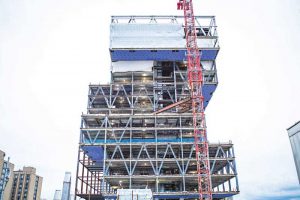
By David Diedrick and Cecile Roman
According to climate experts, rising levels of carbon in the atmosphere will raise worldwide average temperatures by 1.5 degrees between 2030 and 2052. To the average person, a mere 1.5 degrees may seem inconsequential, but even a tenth of a degree can make a significant difference. For example, more heat trapped inside the atmosphere causes the air and water to hold more energy which, in turn, causes severe weather conditions and disasters.
This is far from being a possible concern as its impact is already happening. In 2021, the U.S. experienced an average temperature which was 2.5 degrees above the 20th century average, with $145 billion in property damages due to hurricanes, tornados, wildfires, droughts, and flooding events–the third most costly year on record.¹ Over the last 10 years (2012-2021), there has been at least $1 trillion in disaster damage costs resulting from 142 weather and climate disaster events.
The global climate crisis has reached a critical point. As atmospheric carbon levels continue to increase, so will extreme weather conditions, which means a slew of threats to the health and wellness of people, flora, and fauna worldwide. With buildings accounting for nearly 40 percent of carbon dioxide (CO2) emissions, according to the Global Alliance for Buildings and Construction (GlobalABC), it is understandable why such an immense focus is being placed on them in the quest to achieve net-zero emission targets by 2050. The way the world constructs and manages its buildings is essential for mitigating global warming and its impact on the economy, communities, and ecosystems.
Sustainability attributes of concrete
Sustainable construction considers the entire life cycle of a structure and aims to reduce the environmental damage at every stage, from the initial choice of products to demolition. As the most widely used building material, concrete offers many advantages for meeting the challenges of sustainable development.
Not only is concrete entirely recyclable, but it also has a long lifespan. When produced and sourced locally, it has favorable CO2 and energy footprints in comparison to other building materials. Moreover, well-constructed concrete walls, floors, and roofing elements can be left in place when an existing structure is retrofitted; extending the life of existing buildings and eliminating the carbon footprint associated with new construction. Concrete’s strength, durability, and fire-resistance properties enable the design of high-performance structures by providing effective protection against natural hazards. These attributes add to the exceptional thermal inertia properties of concrete, as it absorbs heat during the day and gives it back at night—significantly lowering energy use by reducing heating and air conditioning requirements.
While concrete is considered a favorable choice for sustainable construction, the material has a high carbon footprint due to the energy intensiveness and generation of CO2 from Portland cement manufacturers. To pursue a net-zero future, concrete needs to have the lowest embodied carbon possible without affecting its performance. For specifiers, the most effective means of achieving this is by reducing the amount of clinker in a mix design by relying on blended cements. This can reduce the carbon emissions of structural systems by up to 40 percent.²





The photo caption to this story has incorrect information: the project One Dalton is located in Boston, Massachusetts – not Washington DC and it is LEED certified Silver, not platinum.
Thanks a lot for pointing that out. We have modified the caption of the photo.